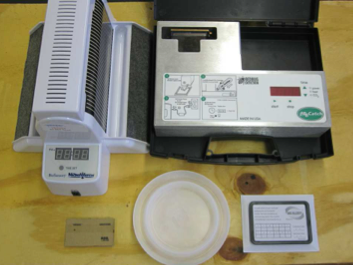[From the December 2012 issue of the UC IPM Retail Nursery & Garden Center News]
After decades of relative obscurity, bed bugs (Figure 1) are exhibiting a global resurgence. In the United States, the Northeast and Midwest regions have been considered bed bug hot spots, with the highest reported incidence, but California has recently experienced a multitude of bed bug reports, with Sacramento experiencing the largest increase in requests for bed bug management services in the country in 2013. Causes for this resurgence may include increased global traffic and commerce, insecticide resistance, and a decrease in indoor residual pesticide applications.
![Figure 1. Bed bug adults (bottom, darker red) and nymphs. All life stages and both sexes of bed bugs preferentially feed on human blood. [Photo courtesy of Dong-Hwan Choe, UC Riverside.] Figure 1. Bed bug adults (bottom, darker red) and nymphs. All life stages and both sexes of bed bugs preferentially feed on human blood. [Photo courtesy of Dong-Hwan Choe, UC Riverside.]](http://ucanr.edu/blogs/UCIPMurbanpests/blogfiles/25055.jpg)
Bed bug monitoring devices purchased online or from retail stores may be useful in detecting an infestation, but if bed bugs are found, it's best to contact a professional for treatment. Bed bug monitors aim to attract or intercept bed bugs during movement between dark hiding places (such as bed frame joints, box springs, behind walls, or in other cracks and crevices near resting and sleeping places) and places where hosts (such as people) rest. PMPs are already widely using these monitors.
Although quite diverse in terms of size, appearance, and price, monitors generally fall within one of two categories: active monitors or passive monitors. Active monitors employ an attractant—usually heat, carbon dioxide, host odors (kairomones), and/or pheromones—to lure bed bugs out of their harborage areas and into a pitfall or sticky trap within the monitor. These devices have the potential, especially in the absence of a host, to detect bed bugs that would normally remain hidden. Passive monitors may either exploit a bed bug's affinity for dark crevices (harborage traps) or simply rely on chance encounters with pitfall or sticky traps. Interceptor monitors are a hybrid between active and passive monitors in that they rely on the presence of a host (sleeping human) to attract hungry bugs and trap them en route to their meal.
Without efficacy data consumers won't know which products will best detect bed bugs. A team of UC researchers, led by UC Berkeley entomologist Vernard Lewis, recently conducted a series of bed bug monitor evaluations, considering active and passive devices available to consumers in stores or online. In these studies, known quantities of hungry adult bed bugs were released into an inescapable arena containing a monitor and several pieces of bedroom furniture and allowed to forage. After 24 hours, researchers recorded where each bed bug was found within the arena.

Although, statistically speaking, the tested monitors harbored no more bed bugs after 24 hours of foraging than did furniture within the arena, research did verify their value as detection devices since monitors are much easier to inspect than cracks and crevices in furniture. All tested monitors recovered at least 5% of the released bed bugs at all release densities.
A trend in the data suggests active monitors may be somewhat more reflective of bed bug density because they recovered a stable proportion of the released bugs regardless of the total number released, while passive monitors recovered a smaller proportion of the total as the total number released increased; however, the passive monitors still always captured bed bugs. Overall these data suggest passive monitors may be just as effective at detection as active monitors—at a fraction of the cost—and all monitors tested may be able to detect bed bugs at very low densities. These five monitors represent only a few of those available, and new devices, especially active monitors utilizing new technology, have come into the market since the culmination of this study.
Bed bug management will continue to be difficult and is best left to experienced PMPs. However, bed bug detection devices, such as the monitors evaluated, may serve as valuable tools for consumers to confirm infestations before calling a professional and may help prevent ineffective, unnecessary, and potentially dangerous do-it-yourself pesticide applications. For more about bed bug biology and management, see the Pest Note: Bed Bugs.
[Updated and modified slightly from the original article in the December 2012 issue of the UC IPM Retail Nursery & Garden Center News]